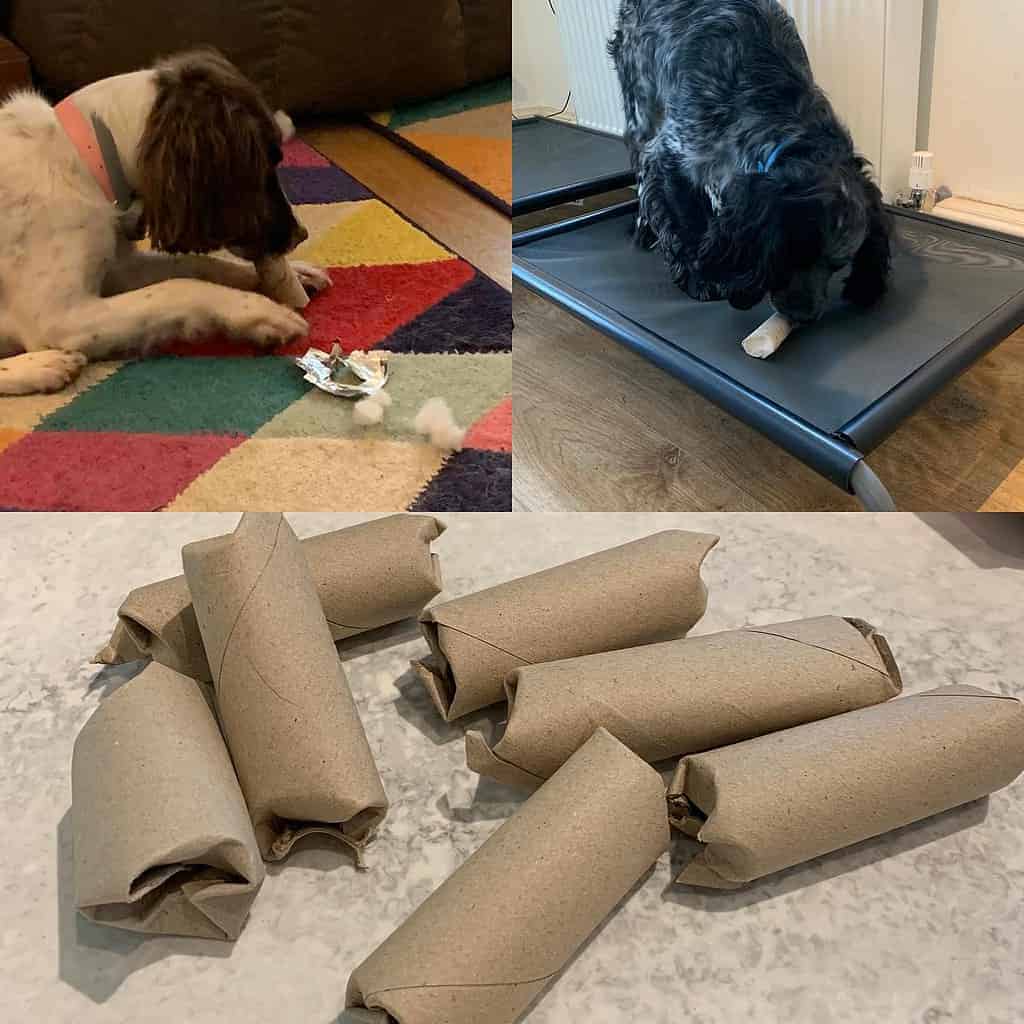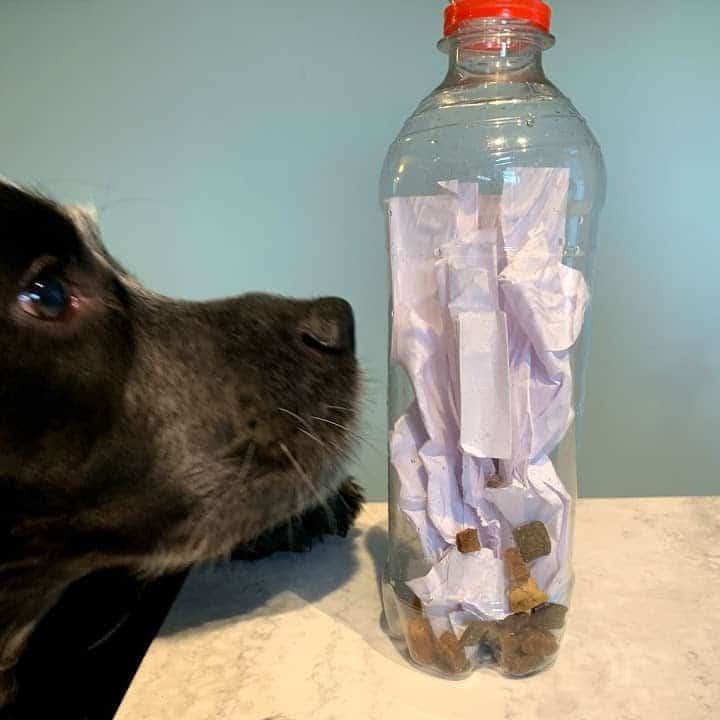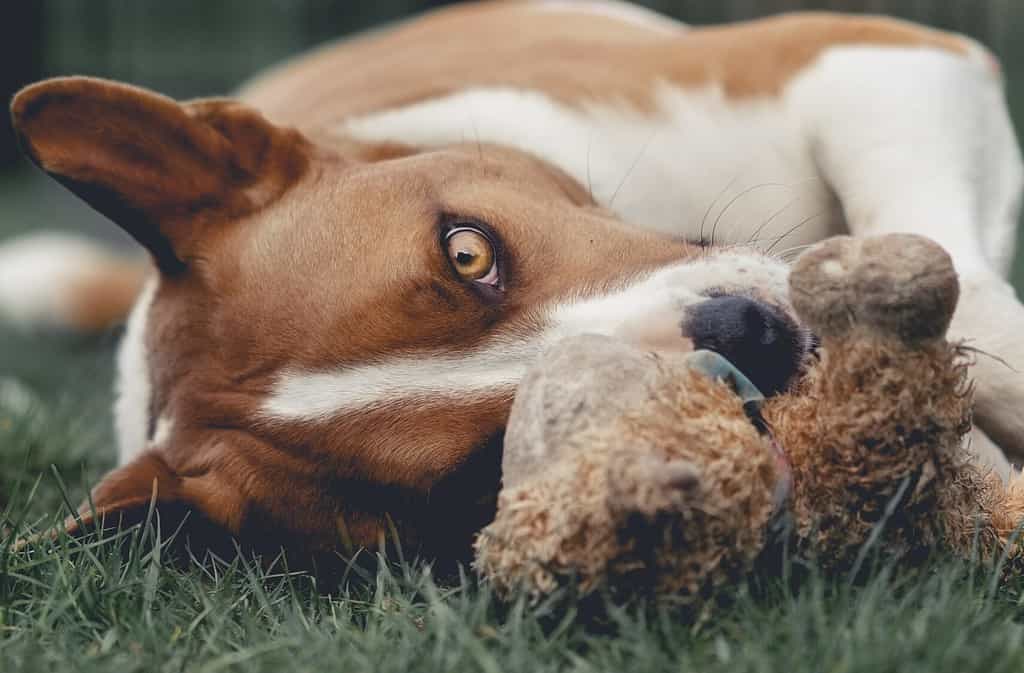If your dog seems bored — chewing the furniture, digging up the garden, or pestering you non-stop — it might be a sign they need more to do, not less energy. Most of the time, what we label as “naughty” behaviour is actually your dog trying to meet a need.
That’s where dog toys for bored dogs come in. These aren’t just things to gnaw on — the best toys tap into your dog’s natural instincts like chewing, sniffing, shredding, and problem-solving. And you don’t have to spend a fortune. Some of the most engaging options can be made from stuff you already have lying around the house.
Before we dive into the DIY ideas, let’s talk about why dogs get bored in the first place – and what you can do to help.
Why Do Dogs Get Bored? (and What Happens When They Do?)
Dogs might seem like they’ve got it pretty cushy — daily walks, a comfy bed, and maybe even a toy box that rivals a toddler’s. But just like us, they need more than physical exercise or a full belly to feel satisfied.
Boredom in dogs usually stems from unmet mental and behavioural needs. Most dogs were originally bred to do specific jobs: herding, hunting, guarding, sniffing, retrieving. While our pet dogs no longer work in the same way, their brains and bodies still crave purpose.
Without enough appropriate outlets, dogs often find their own ways to stay busy… and that’s when the trouble starts.
You might see:
- Chewing furniture or flooring
- Barking at every sound outside
- Digging holes in the garden
- Pacing, whining, or seeming unable to settle
- Following you around obsessively
- General mischief and chaos
What might look like disobedience is usually your dog trying to cope. They’re not giving you a hard time — they’re having a hard time.
The good news is that enrichment and boredom-busting toys can help meet those needs in a safe, satisfying way. Giving your dog something appropriate to shred, sniff, or problem-solve can make a world of difference to their wellbeing — and your sanity.
A quick word about DIYing dog toys:
- Supervise your dog during play. Your DIY toys won’t have rigorous testing for safety and destructibility. You’ll want to make sure that your dog isn’t swallowing chewed up bits etc.
- Don’t use materials that could hurt your dog, either because they are sharp or toxic.
Chewing, Shredding & Dissecting Toys for Bored Dogs
Some dogs just need to destroy something — and that’s not a bad thing! Chewing, shredding, and dissecting are all part of a dog’s natural behavioural repertoire, especially for puppies, adolescents, and high-energy dogs who need an outlet.
Giving your dog safe options for this kind of destruction can prevent furniture casualties, reduce frustration, and satisfy their need to bite, rip, and tear. These DIY toys are perfect for dogs who love to get stuck in with their teeth and paws.
T-Shirt Rope Toy
I have a problem with buying slogan/graphic t-shirts. I just don’t seem to be able to help myself when I see something that makes me snort. That means I’ve got a lot of them piling up that have seen better days.
Making a rope toy out of t-shirts looks easy enough that I’m sure even I could manage it. Bonus is that you can make it just the right thickness and length for your dog, and even include a tennis ball if you want.
If you were more ambitious about the braiding you could try this one.
Toilet Paper or Paper Towel Roll Treat Dispensers
Fill an empty toilet roll with treats. Fold down the ends. Cut a hole or two in the roll that’s big enough for the treat to fall out of. You can even leave out the hole and let them shred the roll to get to the inside. This is so easy to do, the hardest part is collecting the inner rolls.
Personally I let my dogs shred them to get to the insides as they don’t eat the cardboard after tearing it up and it plays into the dissecting part of a dogs natural prey sequence. I’ll often put small chews like chicken feet inside than just small treats or kibble. And if I’m feeling especially inventive I’ll combine it with cardboard boxes filled with safe packing material so they have to work just that little bit harder.
My dogs love this one — it’s one of the easiest dog toys for bored dogs to throw together and taps into their natural urge to dissect and destroy in a safe, satisfying way. As you can see in the photo, Flint and Fraggle are always up for a good shred!

Sniffing & Foraging Toys for Bored Dogs
If your dog enjoys “walks” where their nose does most of the work, they’ll love toys that engage their sense of smell. Foraging taps into species-typical behaviour and gives dogs a chance to use their brain and their body in a focused, calming way.
Sniffing is one of the most powerful ways to help dogs feel relaxed and fulfilled. These DIY toys are a brilliant way to bring the benefits of scentwork indoors — no special training needed!
Muffin Tin Game
Grab a muffin tin, tennis balls and your dog’s favourite treats! Randomly add treats and cover them with tennis balls. Your dog will need to sniff and paw out their reward! This is great for some bonding time and giving their nose a bit of a workout. And it’s often amusing to see the different strategies for removing the tennis balls.
DIY Snuffle Mat
Snuffle mats are interactive feeding mats meets scent game. Dogs will need to use their nose to find the food and to move the strips of material out their way to access it.
There are a lot of creative ones out there. Here’s a DIY Snuffle Mat that I thought looked different to the usual grid mats with knotted fleece strips.
Or you can go old-skool with the tried and trusted rubber mat and knotted fleece strips – easier for those of us who don’t have the sewing skills.
I have made our own fleece snuffle mats, but sadly the dog it was intended for decided that the best most efficient way to find the food was to fling the mat upside down and shake it. Which was not the point. So for him, I made the next item on the list
DIY Snuffle Ball
Made in a similar way to the original snuffle mat, but with a hollee ball as the base. It’s more fiddly to fill with food, but for those dogs that take a more active emptying approach like our Breckin did, it’s perfect.
Here’s how I made our snuffle ball. Breckin seemed to enjoy it at least.
Problem-Solving & Interactive Feeding Toys for Bored Dogs
Some dogs need more than just a chew or a sniff — they want a challenge. Interactive feeding toys and food puzzles are a great way to engage your dog’s brain, slow down fast eaters, and turn mealtimes into mentally enriching experiences.
These toys encourage dogs to think, try new strategies, and often combine physical play with a brain workout. Great for clever dogs, easily bored dogs, or those on restricted exercise who still need stimulation.
Soft drink Bottle Treat Dispenser
Save those 2-litre bottles and turn them into a treat dispenser. Daily Dog Tag has instructions for a fun looking dispenser that any dogs that enjoy bashing things with their paws would probably like.
For something even more simple I just pop some dry treats or kibble into a bottle and let my dogs at it. They seem to like crunching and pouncing and flinging the bottle around. If they become particularly quick at removing the treats, I crumple paper (packing paper works wonders for this) inside the bottle so the treats can’t fall out so quickly.

Shoebox Hide and Seek
Take your dog’s favourite treat and hide them in shoe boxes, or any cardboard box for that matter.
Leave some boxes empty and place treats in others. Have your dog go around searching for the boxes with treats. Make it more challenging by putting the lids on or closing the flaps, or even leaving in some of the packing materials (if safe).
How to Introduce DIY Dog Toys to Your Bored Dog
You’ve got your cardboard boxes, old t-shirts, and empty bottles ready to go — now what?
Before you hand your homemade masterpiece to your dog, there are a few important things to think about. Introducing new toys thoughtfully can make the experience more rewarding (and safer) for your dog — and less frustrating for you!
Here are a few tips to help your DIY enrichment go smoothly:
1. Supervise to Start
DIY toys don’t go through the same rigorous safety checks as commercial ones, so supervision is key. Watch how your dog interacts with the toy — are they chewing, shredding, flinging it around, trying to eat it whole?
Some dogs play gently. Others are like wrecking balls. Know your dog and be ready to step in if they start turning the toy into a snack.
2. Start Easy, Then Make It Harder
If your dog gets frustrated easily, don’t go straight to the trickiest version. Let them succeed a few times first — that builds confidence and keeps their motivation high. You can always make it harder later by:
- Folding boxes closed
- Adding scrunched-up paper to hide treats
- Tying tighter knots in fabric toys
- Cutting fewer holes in toilet rolls or bottles
Think of it like doggie difficulty levels.
3. Match the Toy to Your Dog’s Style
Some dogs love using their nose. Others prefer to dissect and destroy. You might have a problem-solver who’ll spend 15 minutes working out how to get a treat, or a wild child who just wants to fling the toy and see what falls out.
Try different styles and observe what lights your dog up. There’s no one-size-fits-all toy — and part of the fun is figuring out what your dog enjoys most.
4. Rotate Toys to Keep Things Interesting
Dogs can get bored of toys if they see the same ones every day. Keep a small stash of enrichment toys and rotate them every few days — that way, each one feels novel again when it reappears.
You don’t need to make new toys constantly. A simple box or bottle feels brand new with a different filling, scent, or hiding spot.
5. Watch for Overload (Yes, That’s a Thing)
Not all dogs can go from zero to problem-solving hero. If your dog walks away, starts whining, or gets frantic, it might be too hard or too soon. That doesn’t mean the toy is a fail — it just means they need more support or a simpler starting point.
Sometimes the most engaging enrichment is low-key and easy. The goal isn’t to tire your dog out — it’s to help them feel calm, content, and capable.
Items to Save for DIY Dog Toys
Before you toss something in the recycling bin, take a second look — it might be your dog’s next boredom-busting toy.
Here’s a list of everyday household items that are perfect for DIY enrichment. Pop a box or basket somewhere handy and start saving these bits for future fun:
- Empty toilet rolls and kitchen roll tubes – great for stuffing with treats or shredding
- Cardboard boxes of all sizes – from shoeboxes to delivery packaging
- Old t-shirts, towels, or fleece blankets – can be knotted, braided, or turned into snuffle mats
- Plastic drink bottles (with labels and lids removed) – ideal for treat dispensers
- Scraps of fabric or packing paper – perfect for stuffing toys or hiding treats
- Old tennis balls – useful for games like the muffin tin puzzle
- Paper shopping bags – just remove the handles, then stuff with paper and treats
- Bits of rope or fleece strips – good for tug toys and braids
Having a stash of enrichment materials ready to go makes it easier to keep things fresh and interesting for your dog — without extra cost or effort.
When It’s Not Just Boredom: Signs to Speak to Your Vet
Sometimes what looks like boredom is actually something else entirely. If your dog seems “off,” especially if they’re not perking up even when you offer a game or treat, it might be time to dig a little deeper.
Here are some signs that your dog’s behaviour might be down to illness, pain, or anxiety — not just lack of stimulation:
- Sudden lethargy or low energy that doesn’t lift
- Loss of appetite, even with tasty treats
- A change in how they usually play or move (e.g. stiffness, reluctance to chew, clumsiness)
- Disinterest in toys or activities they normally enjoy
- Increased irritability or restlessness
- Excessive licking, panting, or vocalising
If you’re ever unsure, it’s always worth checking in with your vet. Behaviour and health are deeply connected, and catching a problem early can make a big difference.
Want to do more than just manage your dog’s boredom?
DIY toys are a great start, but if your dog’s behaviour is tipping into anxiety, reactivity, or frustration, you might need more than a few enrichment activities. I help dog guardians get to the root of their dog’s behaviour and build calm, connected relationships using kind, science-based coaching.
I work with dogs who struggle with reactivity, anxiety, aggression, and overwhelm — and the people who love them.

